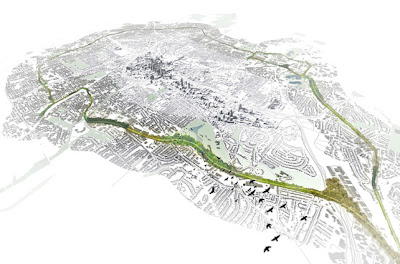Our class last week consisted of a tour of the Southface building, which is located near the Atlanta Civic Center. It was opened slightly over thirty years ago to promote green efficiency as well as quality construction for residential buildings. We learned that in the next forty years 2/3 of all growth in the United States will be in the South, therefore there is an urgent need for sustainable building in future construction projects. Here are some photos of the interesting things that have been used to build Southface:
 |
| windows facing south for maximum sunlight exposure |
 |
| artificial stream for storm water runoff |
 |
| paneled carpeting for easy replacement |
 |
| window shields to distribute sunlight across rooms |
Information about Sustainable Building
from our text, Cities & Nature: (pg.238-240)
1) The basic difference between the 20th century view of housing and the view of the sustainability perspective is that planners previously "tended to view housing within a vast infrastructure grid of gas, electrical power, water supply and sewerage." These grids became quite extensive with urban sprawl and suburban growth. More recently, sustainable housing planners "would localize the impacts of growth by insisting that as many resources as possible (water, energy and food) are source, processed and disposed of locally" (238).
2) In a house, the three main systems that contribute to sustainability are:
- the waste system
(example: a biolytic filter intakes sewage, good waste and other organic material into a multi-layered filter bed concrete tank with worms and micro-organisms. they sift, sort, digest and treat the solid waste and waste water from showers, baths, toilets, sinks, and dishwashers. it is then pumped into a UV-tank to further clean the water, which can then be used to water a garden.)
- the drinking water system
(example: rooftop rainwater collection tanks can collect and filter rain to be used for watering gardens and as drinking water)
- the solar energy system \
(example: photovoltaic cell solar panels)
3) Building materials are also an important part of sustainable building. The use of re-growth timber or materials produced by pollution-free manufacturing and free of toxic chemical discharges is necessary. (example: thick straw bales as wall insulation) Many use stoves which burn wood pellets or corn kernels instead of natural gas furnaces. Also, concrete flooring keeps a house cooler in summers and warmer in winters.
4) A very important concern for building sustainably is to maximize the use of the Sun during winter months to provide light and warmth by having the main windows of the house facing south, in the northern hemisphere.
5) Some suggestions for building materials in green buildings are as follows:
- non-formaldehyde and/or non-toxic properties (improves indoor air quality)
- high renewability or reusability (bamboo flooring, cork titles, etc.)
6) The advantages of green roofs include:
- soaking up rain water instead of funneling runoff into sewers
- reducing energy costs (summer AC needs, winter heating)
- lowering carbon dioxide levels
- providing bird habitats
- removing nitrogen and other pollutants from rainfall
- diminishing the 'Urban Heat Island' effect









































